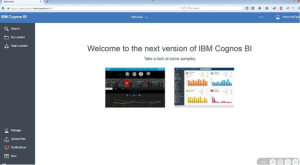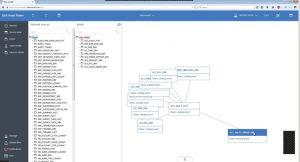Cognos Analytics: Top 4 Release Features from Insight 2015
This year’s IBM Insight conference has been chock full of many exciting announcements so far, including news about the next version of Cognos BI – Cognos Analytics.
Scheduled for general release by the end of 2015, Cognos Analytics promises an improved total experience for the entire analytics community from the business user to the IT developer, delivering enhanced usability focused on bringing together self-service and governance, two areas often thought to be incompatible. Cognos Analytics aims to change that perception by addressing both the increasing pressure for self-service and the critical need for governance in one elegant and intuitive enterprise-ready platform.
Now that we’ve had an opportunity to glimpse into the future a bit during the Insight keynote this morning, let’s consider the new release in terms of the existing version of Cognos BI, the competition, and the analytics ecosystem in general. Here are the top 4 elements of Cognos Analytics that Ironside feels will have the biggest impact.
1. Enhanced User Experience
Compared to earlier versions of Cognos, what is most striking about Cognos Analytics is the new interface. It’s attractive, clean, and crisp, hiding excess adornment and focusing the end user on the important elements they need to leverage to start authoring compelling reports, dashboards and visualizations. The best part is none of the back-end functionality is lost and it’s easy to access the power that Cognos experts and experienced users have grown accustomed to with advanced features just a few clicks away.
This “graduated” single interface is compelling from a total cost of ownership perspective – there is only one place for users to go, only one interface to learn – which will reduce confusion and enhance self-service capability further. This marks a refinement of the features we have seen in the evolution of Cognos, including a welcome rationalization of the various authoring studios.
2. Streamlined Modeling
From a modeling perspective, we see the consolidation of several recent capabilities like External Data and My Data Sets with vastly improved execution. This streamlined approach to the end user experience of enhancing existing data sets with their own data will no doubt accelerate the adoption of self service and deliver the simplified functionality found in competitive products.
One of the most impressive features is the improvement and prominence of the search functionality and its harmonization with what has been described as the “intent-driven” experience of authoring and modeling.
As Cognos professionals, we very frequently hear from customer end users that they can’t find the information they are looking for on their own, and many times fall back to a legacy approach of extracting from Cognos the sometimes disparate data elements they need for business questions and building out “spreadmarts” offline to answer them. The new and improved search functionality, as well as the many other new features, will help curtail such user behavior and help solve the governance issues that arise from it.
This new modeling approach also lets users combine data sets from enterprise data sources and files to create data modules that enhance analysis as business needs require. A representative use case for this process might be a Sales Director needing to analyze sales by a regional structure not yet loaded into the enterprise warehouse. Once created, these new assets can be shared in public locations as appropriate to be leveraged by other users. The modeling interface also supports the intent-based approach exposed in the authoring interface, allowing a user to type in terms and find data modules and sources that match. From there, the user can do some interrogation to understand if the any of the proposed data modules have the type and style of information they are looking for.
3. Mobile-First Mentality
The seamless integration of the mobile experience into a single interface is a very welcome development promised with Cognos Analytics and will again help drive self-service adoption. In earlier Cognos versions, most mobile-centric functionality remained tied to specific report formats, like active reports, or was reliant on its own separate Cognos Mobile interface. With Cognos Analytics, it’s all getting merged together, which will make authoring for and transitioning between devices much easier to accomplish than in the past.
This focus on mobile is going to make a big difference in both enabling access to analytics across organizations and keeping Cognos in step with some of its more mobile-friendly competitors. Here once again, we see the potential for blending the enterprise-oriented power the platform has historically excelled at delivering with the flexibility, agility, and visual richness across all viewing formats that users have come to expect from modern analytics tools.
4. Built-In Guidance
Cognos Analytics also supports “intent-driven authoring” instead of leaving the user with a blank canvas from which to start. Leveraging a feature set introduced in IBM Watson Analytics, the user is provided with suggestions based on their input to provide a better authoring experience, the “best defaults by default” based on the data. Even though this kind of assistance is now an option, power users and developers aren’t limited in the new interface as advanced features are still available. This is a key point of distinction, since many of the other analytics tools in the marketplace focus much more heavily on a guided approach and leave power users stuck in a process that may slow down their progress in achieving analysis goals.
By providing for the full spectrum of user personas, Cognos Analytics looks to be creating a truly centralized hub for business analytics that will be able to perform advanced processes and also lead more users to the actionable intelligence they need. Also, all signs point to strong integration with even more intensive activities like data science, meaning that predictive data will be readily usable too.
Cognos Analytics: At the Intersection of Self Service and Governance
According to Gartner, “the Self Service market with grow at 30%” yet “90% of business intelligence initiatives will be governed insufficiently to prevent inconsistencies that adversely affect the business”. As many business intelligence practitioners have discovered, self-service is here to stay, but it can be difficult to ensure that the self-service analyses taking place are based on a foundation of quality. Business users act to find solutions to their analytics challenges on their own, with governance sometimes being a lesser priority in the face of the quest to find an answer. Business analytics tools need to walk a thin line in order to deliver the easy accessibility and visualization capabilities expected in the modern marketplace while also remaining committed to high standards of data cleanliness and accuracy. It looks like Cognos Analytics will take some critical steps toward making this kind of balanced approach a reality.
So with all these innovations coming down the pipeline, what about the considerable investment that customers have made in their Cognos BI environments to date? Early feedback suggests that existing investments made will be protected, with existing reports and metadata models/packages easily migrated to Cognos Analytics. This will ensure a smooth transition to this radically updated take on the traditional BI platform we’ve all come to know.
If you want to get your organization up to speed on Cognos Analytics, check out our Cognos Analytics resource center and ensure that you can transition smoothly to this new and powerful environment.







